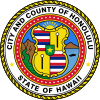
Hawaii Five-O is an American police procedural drama series produced by CBS Productions and created by Leonard Freeman. Set in Hawaii, the show originally aired for 12 seasons on CBS from September 20, 1968, to April 8, 1980, and continues in reruns. At the airing of its last episode, it was the longest-running police drama in American television history, and the last scripted primetime show that debuted in the 1960s to leave the air.

Chang Apana (December 26, 1871 – December 8, 1933; traditional Chinese: 鄭阿平; simplified Chinese: 郑阿平; pinyin: Zhèng Āpíng; Wade–Giles: Cheng4 A1p'ing2; Jyutping: Zeng6 Aa3ping4) was a Chinese-Hawaiian member of the Honolulu Police Department, first as an officer, then as a detective. He was acknowledged by Earl Derr Biggers as the inspiration for his fictional Chinese American detective character, Charlie Chan.
Inspector, also police inspector or inspector of police, is a police rank. The rank or position varies in seniority depending on the organization that uses it.

The Houston Police Department (HPD) is the primary municipal law enforcement agency serving the City of Houston, Texas, United States and some surrounding areas. With approximately 5,300 officers and 1,200 civilian support personnel it is the fifth-largest municipal police department, serving the fourth-largest city in the United States. Its headquarters are at 1200 Travis in Downtown Houston.
Blood & Orchids is a 1986 made-for-TV crime-drama film. Written for the screen by Norman Katkov, it was an adaptation of Katkov's own novel which, in turn, was inspired by the 1932 Massie Trial in Honolulu, Hawaii. It was typical of many crime dramas produced during the period.

The Hawaii Department of Public Safety was a department within the executive branch of the government of the U.S. state of Hawaii. It was headquartered in the 919 Ala Moana Boulevard building in Honolulu, Hawaii. At the time of its deactivation, the Department of Public Safety was made up of three divisions: Administration, Corrections, and Law Enforcement.

Herman John Wedemeyer was an American actor, football player, and politician. He is best known for portraying Sergeant/Detective "Duke" Lukela on the crime drama Hawaii Five-O (1972–1980). He also appeared on the first episode of Hawaii Five-O as Lt. Balta of Honolulu Police Department.

The history of the Houston Police Department started with the founding of the City of Houston. While the department's beginning was humble, it grew more advanced as technology became available and was able to handle the various challenges that would plague various cities as well as some of the more distinctive aspects of its geography.

The Hillsboro Police Department (HPD) is the municipal law enforcement agency of the city of Hillsboro, Oregon, United States. It is a regionally accredited agency with 127 sworn officers on the force. The chief is Jim Coleman in a city of over 90,000 residents west of Portland, Oregon, in Washington County. With 169 employees as of 2014, the department is the second largest police force in the county and seventh largest in Oregon.

In the United States, a sheriff is the chief of law enforcement of a county. Sheriffs are usually either elected by the populace or appointed by an elected body.

Kymberly Marcos Pine is an American politician and Democrat who served two terms on the Honolulu City Council representing District 1 from 2013 to 2021. She was the Chair of the Council Committee on Business, Economic Development and Tourism. Prior to being elected to the City Council, she served as a Representative to the State House of Representatives for four terms. On October 28, 2019, Pine announced her candidacy for Mayor of Honolulu.

Hawaii Five-0 is an American action police procedural television series that centers around a special police major crimes task force operating at the behest of the governor of Hawaii. It is a reboot of the 1968–1980 series Hawaii Five-O, which also aired on CBS. The series was produced by K/O Paper Products and 101st Street Television, initially in association with CBS Television Studios. The show received praise for its modern take on the original series.
Rodney Joseph Johnson was a Houston Police officer who served 14 years with the agency prior to his death in the line of duty on September 21, 2006.

The Hawaii Division of Conservation and Resources Enforcement (DOCARE) and also known as the Hawaii DLNR Police, is the law enforcement agency for the Hawaii Department of Land and Natural Resources. It is tasked with full state police powers to enforces all State laws and Department rules, with primary jurisdiction involving State lands, State Parks, historical sites, forest reserves, aquatic life and wildlife areas, coastal zones, Conservation districts, State shores, as well as county ordinances involving county parks, for enforcing Hawaii's fishing and recreational boating laws and protecting reefs and other marine resources, patrolling harbors and coastal areas, and conducting marijuana eradication missions.

Magnum P.I. is an American action drama television series developed by Peter M. Lenkov and Eric Guggenheim. It stars Jay Hernandez as Thomas Magnum, the titular private investigator and former Navy SEAL who solves crimes in Hawaii. It is a reboot of the original series of the same name created by Donald P. Bellisario and Glen A. Larson, which aired from 1980 to 1988. The series co-stars Perdita Weeks, Zachary Knighton, Stephen Hill, Amy Hill, and Tim Kang.
Katherine Puana Kealoha is a former Deputy Prosecutor with the City and County of Honolulu and a convicted felon. She resigned from the position of deputy prosecutor in September 2017 after she and her husband Louis Kealoha were indicted on eight counts of bank fraud. Her husband is a former Chief of Police.
On April 5, 2021, Micronesian 16-year-old Iremamber Sykap was killed on Kalākaua Avenue when Honolulu police officer Geoffrey Thom fired 10 rounds at Sykap through the rear window of a stolen car after it had stopped at an intersection following a police pursuit. Thom was charged with second-degree murder for the shooting, and two other Honolulu Police Department officers were charged with attempted second-degree murder. The charges were dismissed in district court on August 18, 2021.
Louis Kealoha is a former Chief of the Honolulu Police Department. He joined the department in 1983 and was promoted to Chief on November 25, 2009. Following his appointment, he and his wife Katherine Kealoha threw a lavish party, spending $26,000 which had been stolen from Katherine's grandmother.

Lucile Abreu was an American police officer, known for her work promoting gender equality in the Hawaiian police force. In 1972 she sued the Honolulu Police Department for discriminatory hiring and promotion practices; the suit was settled in her favor. As a result of her lawsuit the Honolulu Police Department changed their hiring policies.




















